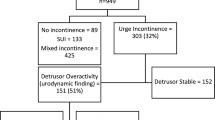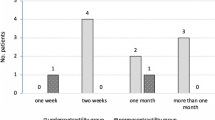Abstract
Introduction and hypothesis
The association between pelvic organ prolapse (POP) and detrusor underactivity (DU) is not well defined. The primary outcome of this study was to evaluate the prevalence of DU in a cohort of patients with POP and its association with symptoms, anatomy. and urodynamic findings. The secondary outcome was to evaluate the evolution of lower urinary tract symptoms after POP repair between DU and non-DU patients.
Methods
Consecutive patients who underwent preoperative urodynamic tests were retrospectively analyzed. Detrusor underactivity was evaluated by the Bladder Contractility Index (BCI = pDetQmax + Qmax × 5) proposed by Abrams. A BCI < 100 was considered indicative of an underactive bladder. Patients with underactive bladder were considered group A, whereas the remaining patients were classified as group B.
Results
A total of 518 patients were studied. According to BCI, detrusor underactivity was identified in 212 (40.9%) patients (group A). Group A showed higher rates of voiding symptoms (59.4% vs 36.3%, p < 0.0001) and positive (>100 ml) postvoid residual (29.7% vs 9.8%, p < 0.0001). Conversely, they displayed lower rates of urge incontinence (15.1% vs 23.2%, p = 0.02) and detrusor overactivity (15.6% vs 23.9%, p = 0.02). Preoperative Pelvic Organ Prolapse Quantification (POP-Q) demonstrated greater Aa (+1.1 ± 1.5 vs +0.9 ± 1.5, p = 0.03) and Ba (+1.4 ± 1.7 vs +1.2 ± 1.7, p = 0.04) points values in patients in group A. After POP surgery, postoperative voiding symptoms were similar in the two groups (16% vs 15.7%, p = 0.91).
Conclusions
Our study showed a 40.9% prevalence of DU in POP patients. DU was associated with the presence of voiding symptoms and positive PVR. Moreover, cystocele showed to be more severe in DU group. After surgical repair of POP, voiding symptoms of DU patients became equal to non-DU ones, suggesting that obstruction removal might recover DU in these patients.
Similar content being viewed by others
References
Ballert KN. Urodynamics in pelvic organ prolapse: when are they helpful and how do we use them? Urol Clin N Am. 2014;41(3):409–417, viii. https://doi.org/10.1016/j.ucl.2014.04.001.
Andersson KE. Bladder underactivity. Eur Urol. 2014;65(2):399–401.
Abrams P, Cardozo L, Fall M, Griffiths D, Rosier P, Ulmsten U, et al. The standardisation of terminology of lower urinary tract function: report from the standardisation sub-committee of the International Continence Society. Neurourol Urodyn. 2002;21(2):167–78.
Griffiths DJ, van Mastrigt R, Bosch R. Quantification of urethral resistance and bladder function during voiding, with special reference to the effects of prostate size reduction on urethral obstruction due to benign prostatic hyperplasia. Neurourol Urodyn. 1989;8:29–52.
Schafer W. Analysis of bladder-outlet function with the linearized passive urethral resistance relation, linPURR, and a disease-specific approach for grading obstruction: from complex to simple. World J Urol. 1995;13(1):47–58.
Abrams P. Bladder outlet obstruction index, bladder contractility index and bladder voiding efficiency: three simple indices to define bladder voiding function. BJU Int. 1999;84(1):14–5.
Van Koeveringe GA, Vahabi B, Andersson KE, Kirschner-Herrmans R, Oelke M. Detrusor underactivity: a plea for new approaches to a common bladder dysfunction. Neurourol Urodyn. 2011;30(5):723–8.
Andersson KE. The many faces of impaired bladder emptying. Curr Opin Urol. 2014;24(4):363–9.
Osman NI, Chapple CR, Abrams P, Dmochowski R, Haab F, Nitti V, et al. Detrusor underactivity and the underactive bladder: a new clinical entity? A review of current terminology, definitions, epidemiology, aetiology, and diagnosis. Eur Urol. 2014;65(2):389–98.
Jeong SJ, Kim HJ, Lee YJ, Lee JK, Lee BK, Choo YM, et al. Prevalence and clinical features of detrusor underactivity among elderly with lower urinary tract symptoms: a comparison between men and women. Korean J Urol. 2012;53(5):342–8.
Bump RC, Mattiasson A, Bo K, Brubaker LP, DeLancey JO, Klarskov P, et al. The standardization of terminology of female pelvic organ prolapse and pelvic floor dysfunction. Am J Obstet Gynecol. 1996;175(1):10–7.
Abrams P, Andersson KE, Birder L, Brubaker L, Cardozo L, Chapple C, et al. Fourth international consultation on incontinence recommendations of the International Scientific Committee: evaluation and treatment of urinary incontinence, pelvic organ prolapse, and fecal incontinence. Neurourol Urodyn. 2010;29(1):213–40.
Milani R, Frigerio M, Cola A, Beretta C, Spelzini F, Manodoro S. Outcomes of transvaginal high uterosacral ligaments suspension: over 500-patient single-center study. Female Pelvic Med Reconstr Surg. 2017. https://doi.org/10.1097/SPV.0000000000000403.
Milani R, Frigerio M, Manodoro S, Cola A, Spelzini F. Transvaginal uterosacral ligament hysteropexy: a retrospective feasibility study. Int Urogynecol J. 2017;28(1):73–6.
Spelzini F, Frigerio M, Manodoro S, Interdonato ML, Cesana MC, Verri D, et al. Modified McCall culdoplasty versus Shull suspension in pelvic prolapse primary repair: a retrospective study. Int Urogynecol J. 2017;28(1):65–71.
Haylen BT, de Ridder D, Freeman RM, Swift SE, Berghmans B, Lee J, et al. An International Urogynecological Association (IUGA)/International Continence Society (ICS) joint report on the terminology for female pelvic floor dysfunction. Neurourol Urodyn. 2010;29(1):4–20.
Gilleran JP, Lemack GE, Zimmern PE. Reduction of moderate-to-large cystocele during urodynamic evaluation using a vaginal gauze pack: 8-year experience. BJU Int. 2006;97(2):292–5.
Seki N, Shahab N, Hara R, Takei M, Yamaguchi A, Naito S. Voiding dynamics in women with stress urinary incontinence and high-stage cystocele. Int J Urol. 2011;18(3):219–24.
Abarbanel J, Marcus EL. Impaired detrusor contractility in community-dwelling elderly presenting with lower urinary tract symptoms. Urology. 2007;69(3):436–40.
Saito M, Yokoi K, Ohmura M, Kondo A. Effects of partial outflow obstruction on bladder contractility and blood flow to the detrusor: comparison between mild and severe obstruction. Urol Int. 1997;59(4):226–30.
Levin RM, Longhurst PA, Barasha B, McGuire EJ, Elbadawi A, Wein AJ. Studies on experimental bladder outlet obstruction in the cat: long-term functional effects. J Urol. 1992;148(3):939–43.
Abdel Raheem A, Madersbacher H. Voiding dysfunction in women: how to manage it correctly. Arab J Urol. 2013;11(4):319–30.
Jeong SJ, Lee JK, Kim KM, Kook H, Cho SY, Oh SJ. How do we diagnose detrusor underactivity? Comparison of diagnostic criteria based on an urodynamic measure. Investig Clin Urol. 2017;58(4):247–54.
Romanzi LJ, Chaikin DC, Blaivas JG. The effect of genital prolapse on voiding. J Urol. 1999;161(2):581–6.
Kira S, Mitsui T, Kobayashi H, Haneda Y, Sawada N, Takeda M. Detrusor pressures in urodynamic studies during voiding in women. Int Urogynecol J. 2017;28(5):783–7.
Park J, Palmer MH. Factors associated with incomplete bladder emptying in older women with overactive bladder symptoms. J Am Geriatr Soc. 2015;63(7):1426–31.
Gammie A, Kaper M, Dorrepaal C, Kos T, Abrams P. Signs and symptoms of detrusor underactivity: an analysis of clinical presentation and Urodynamic tests from a large group of patients undergoing pressure flow studies. Eur Urol. 2016;69(2):361–9.
Van Koeveringe GA, Rademakers KL. Factors impacting bladder underactivity and clinical implications. Minerva Urol Nefrol. 2015;67(2):139–48.
Chancellor MB. The overactive bladder progression to underactive bladder hypothesis. Int Urol Nephrol. 2014;46(Suppl 1):S23–7.
Griffiths DJ, McCracken PN, Harrison GM, Gormley EA, Moore KN. Urge incontinence and impaired detrusor contractility in the elderly. Neurourol Urodyn. 2002;21(2):126–31.
Araki I, Haneda Y, Mikami Y, Takeda M. Incontinence and detrusor dysfunction associated with pelvic organ prolapse: clinical value of preoperative urodynamic evaluation. Int Urogynecol J Pelvic Floor Dysfunct. 2009;20(11):1301–6.
Nishijima S, Sugaya K, Miyazato M, Kadekawa K, Oshiro Y, Uchida A, et al. Restoration of bladder contraction by bone marrow transplantation in rats with underactive bladder. Biomed Res. 2007;28(5):275–80.
Al-Hayek S, Thomas A, Abrams P. Natural history of detrusor contractility—minimum ten-year urodynamic follow-up in men with bladder outlet obstruction and those with detrusor. Scand J Urol Nephrol Suppl. 2004;215:101–8.
Author information
Authors and Affiliations
Corresponding author
Ethics declarations
Conflicts of interest
None.
Rights and permissions
About this article
Cite this article
Frigerio, M., Manodoro, S., Cola, A. et al. Detrusor underactivity in pelvic organ prolapse. Int Urogynecol J 29, 1111–1116 (2018). https://doi.org/10.1007/s00192-017-3532-z
Received:
Accepted:
Published:
Issue Date:
DOI: https://doi.org/10.1007/s00192-017-3532-z




